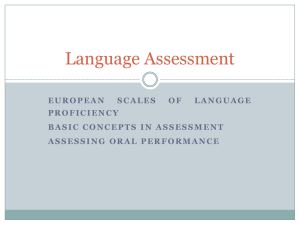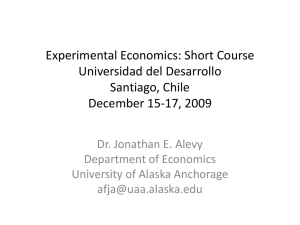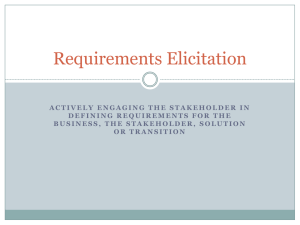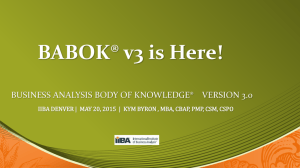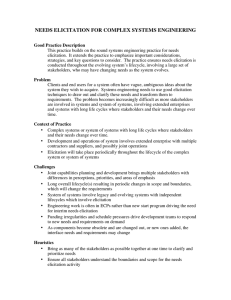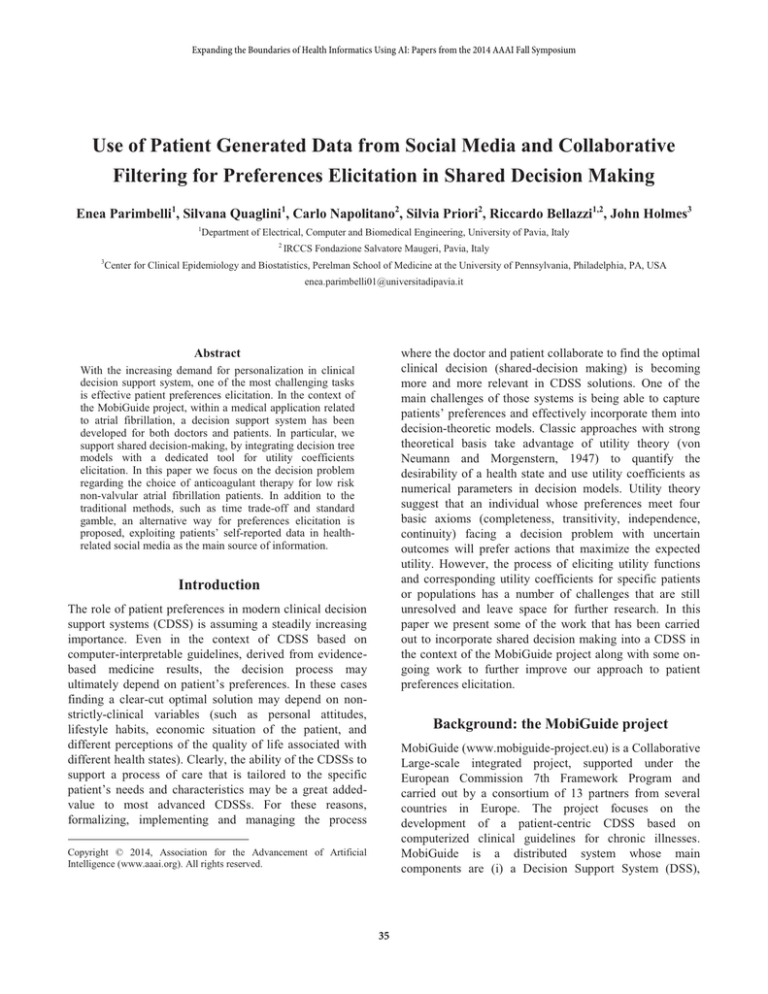
Expanding the Boundaries of Health Informatics Using AI: Papers from the 2014 AAAI Fall Symposium
Use of Patient Generated Data from Social Media and Collaborative
Filtering for Preferences Elicitation in Shared Decision Making
Enea Parimbelli1, Silvana Quaglini1, Carlo Napolitano2, Silvia Priori2, Riccardo Bellazzi1,2, John Holmes3
1
Department of Electrical, Computer and Biomedical Engineering, University of Pavia, Italy
2
IRCCS Fondazione Salvatore Maugeri, Pavia, Italy
3
Center for Clinical Epidemiology and Biostatistics, Perelman School of Medicine at the University of Pennsylvania, Philadelphia, PA, USA
enea.parimbelli01@universitadipavia.it
where the doctor and patient collaborate to find the optimal
clinical decision (shared-decision making) is becoming
more and more relevant in CDSS solutions. One of the
main challenges of those systems is being able to capture
patients’ preferences and effectively incorporate them into
decision-theoretic models. Classic approaches with strong
theoretical basis take advantage of utility theory (von
Neumann and Morgenstern, 1947) to quantify the
desirability of a health state and use utility coefficients as
numerical parameters in decision models. Utility theory
suggest that an individual whose preferences meet four
basic axioms (completeness, transitivity, independence,
continuity) facing a decision problem with uncertain
outcomes will prefer actions that maximize the expected
utility. However, the process of eliciting utility functions
and corresponding utility coefficients for specific patients
or populations has a number of challenges that are still
unresolved and leave space for further research. In this
paper we present some of the work that has been carried
out to incorporate shared decision making into a CDSS in
the context of the MobiGuide project along with some ongoing work to further improve our approach to patient
preferences elicitation.
Abstract
With the increasing demand for personalization in clinical
decision support system, one of the most challenging tasks
is effective patient preferences elicitation. In the context of
the MobiGuide project, within a medical application related
to atrial fibrillation, a decision support system has been
developed for both doctors and patients. In particular, we
support shared decision-making, by integrating decision tree
models with a dedicated tool for utility coefficients
elicitation. In this paper we focus on the decision problem
regarding the choice of anticoagulant therapy for low risk
non-valvular atrial fibrillation patients. In addition to the
traditional methods, such as time trade-off and standard
gamble, an alternative way for preferences elicitation is
proposed, exploiting patients’ self-reported data in healthrelated social media as the main source of information.
Introduction
The role of patient preferences in modern clinical decision
support systems (CDSS) is assuming a steadily increasing
importance. Even in the context of CDSS based on
computer-interpretable guidelines, derived from evidencebased medicine results, the decision process may
ultimately depend on patient’s preferences. In these cases
finding a clear-cut optimal solution may depend on nonstrictly-clinical variables (such as personal attitudes,
lifestyle habits, economic situation of the patient, and
different perceptions of the quality of life associated with
different health states). Clearly, the ability of the CDSSs to
support a process of care that is tailored to the specific
patient’s needs and characteristics may be a great addedvalue to most advanced CDSSs. For these reasons,
formalizing, implementing and managing the process
Background: the MobiGuide project
MobiGuide (www.mobiguide-project.eu) is a Collaborative
Large-scale integrated project, supported under the
European Commission 7th Framework Program and
carried out by a consortium of 13 partners from several
countries in Europe. The project focuses on the
development of a patient-centric CDSS based on
computerized clinical guidelines for chronic illnesses.
MobiGuide is a distributed system whose main
components are (i) a Decision Support System (DSS),
Copyright © 2014, Association for the Advancement of Artificial
Intelligence (www.aaai.org). All rights reserved.
35
life years of the patient. However the length of expected
life is not the only relevant outcome to consider, as quality
of life (QoL) has also to be taken into account. Quality
Adjusted Life Years (QALYs) incorporate mortality and
morbidity in a single quantity by combining a patient's
expected life years with the quality of those life years.
More precisely, the number of years spent in a certain
health state is “weighted” by a multiplicative utility
coefficient (UC), which values the quality of that health
state. UCs range from 0 (death) to 1 (perfect health), and
they are, in principle, very subjective values, since they
reflect a patient’s feeling about a health state. For this
reasons the use of proper and highly personalized UCs can
be an effective way to incorporate patient preferences into
a medical decision problem. Authors of many publications
involving the use of DTs and QALYs (e.g. cost/utility
analyses) often use UCs available in the literature to
quantify their models, disregarding that they could have
been derived from a different population. However, it is
nowadays acknowledged that environmental data play an
important role in quality of life assessment (Ryder et al.,
2009). An alternative approach consists in obtaining UCs
for each specific patient directly to guarantee the best
degree of personalization of the decision problem. For this
purpose we developed a web-based software tool named
UceWeb. Our tool supports three of the main elicitation
methods described in the literature, namely Standard
Gamble (SG), Time Trade-off (TTO), and Rating Scale
(RS).
SG has its theoretical basis directly in the axioms of Von
Neumann-Morgenstern utility theory (Gafni, 1994). The
patient is asked to choose, within a hypothetical scenario,
between living the rest of his life in the health state that is
being evaluated or accepting a gamble whose outcomes are
complete healing or sudden, painless death with probability
p. The more a patient is experiencing a poor QoL, the
higher risk he would accept to have a chance of healing.
The probability p is then varied until the patient is
indifferent between the two choices. Then UC is calculated
as (1-p).
In TTO (Torrance et al., 1972) the patient is asked to
choose between living his entire remaining life (t1) in the
specific health state being evaluated or to live shorter
(t2<t1) but in a perfect health state. If the patient is
experiencing really poor QoL he will be willing to trade
some of his remaining expected life (i.e. to live shorter) for
a better QoL. Similarly to p in SG, the amount of time a
patient is proposed to give up to heal completely is varied
until the patient is indifferent between the two choices. The
UC is then calculated as t2/t1.
Finally, in RS, an analogue scale is presented to the
patient, ranging from 0, associated to the worst health state
imaginable (usually death), to 100, corresponding to
perfect health. The patient is asked to place a marker on the
Figure 1 - Simplified representation of the Oral
Anticoagulant Therapy DT and Markov model.
devoted to the representation and execution of ComputerInterpretable Guidelines, (ii) a Body Area Network (BAN)
including a network of sensors and a smartphone to
support telemonitoring of the patient, and (iii) a Patient
Health Record (PHR) for centralized storage of patients’
data. Among the challenging objectives of the project, one
involves the identification in the clinical guideline for the
treatment of Atrial Fibrillation (AF) of those
recommendations where a shared decision between care
provider and patient is required. The implementation of
these shared decision processes leads to two main action
points: developing decision theoretic models to represent
the decision tasks and collecting patients’ preferences to
run personalized models.
Decision trees and direct elicitation of
preferences
The core of the MobiGuide approach to shared decisions is
to use decision trees (DTs) with embedded Markov models
as a suitable probabilistic, graphical decision-theoretic
formalism for representing and executing decision tasks
(Quaglini et al., 2013). Although the long term decision
making process can be represented as a Markov Decision
Process the scenario we are addressing involves a single
decision point, which can be modeled using a DT. In
particular, we have developed a DT for the choice of
anticoagulant therapy for low risk non-valvular AF patients
(Rognoni et al., 2014). As shown in Figure 1, a list of
possible decision options branch from the initial node of
the DT. A Markov process starts at the end of each branch,
representing the most relevant comorbidities and
complications that the patient could experience in the
future. The transition probabilities between pairs of health
states depend on the therapeutic option.
Running the decision model results in the calculation,
for each of the decision options, of the expected amount of
36
scale according to the degree of desirability of the health
state being evaluated. RS is usually quickly understood by
patients and it is often used to order health states from the
less to the most desirable, as multiple states can be placed
along the scale in one go. However the value produced by
RS is not a true UC (Torrance et al., 2001) but rather what
is called a “value”, calculated as x/100 where x is the
marker position on the scale.
On the other hand, the availability and relevance of raw
data about patients’ preferences, QoL and other healthrelated information is growing. More and more often
patients report their status, share their experiences and
discuss their health in discussion boards and other social
platforms. This kind of user-generated data has been
widely used in the industry to get valuable knowledge
about people’s preferences. The application of
collaborative filtering and recommender systems (Su and
Khoshgoftaar, 2009) is nowadays very popular in the
marketing and sales departments of major companies.
However the potential of these techniques have not been so
widely explored in the field of health-informatics until
now.
Using social media and collaborative filtering
for preferences elicitation
Motivation
A significant effort has been devoted to carefully design
the UceWeb tool to optimize the process of UC elicitation
and achieve the double goal of interface usability and
accuracy/reliability of the resulting UCs. However some
limitations of the current direct elicitation approach are still
hard to overcome. UC elicitation methods like SG or TTO,
albeit theoretically sound, are often difficult to understand
for patients. SG asks the patient to evaluate a hypothetical
risk of death, which some patients with severe conditions
might not be willing to reason upon. Similarly, many
different variants of TTO have been developed to try to
overcome some of its limitations (Buckingham et al.,
1996). On the other hand, ability to correctly understand
the questions is essential to guarantee the quality of the
elicitation results. This is one of the reasons why elicitation
is usually assisted by a trained professional (physician or a
psychologist). However the presence of a human
interviewer can add some significant bias and anchoring
effects. For example the value chosen for the initial
question ("...would you take a 5% risk of death?...") in the
SG method can indeed lead responses to cluster around
that value (anchoring), and it could be influenced by the
physician’s knowledge on the actual surgical risk of an
intervention the patient could undergo (bias). Another
factor that can impact the effectiveness of direct elicitation
is the need for the patients to evaluate unfamiliar health
states. As a matter of fact, in a shared decision-making
framework, often there is the need to represent in formal
decision models possible future health states that can occur
as consequences of the different treatments being
evaluated. Patients can have a hard time in answering the
UC elicitation questions for health states they are not
experiencing at the moment or have never experienced in
their lives. Finally all the issues that affect direct elicitation
can be even more evident in particular groups of patients
like the elderly or those having cognitive impairment. In
extreme albeit not so rare cases, direct elicitation might
also result impossible to perform.
The envisioned novel approach
We are currently investigating the possible benefits of
using text mining and artificial intelligence methodologies
in the process of eliciting parameters related to QoL and
patients’ preferences. Our chosen reference use-case is the
elicitation of utility coefficients of the health states
represented in the previously described DT model
developed for MobiGuide. An outline of the envisioned
logical architecture of the system is shown in Figure 2.
The growing amount of data self-generated by patients
can be a valuable resource to get insights about patients’
experiences, opinions and preferences. An initial corpus is
being built from medical discussion boards using the
medpie framework (A. Benton et al., 2012), which includes
a de-identification module to comply with ethical and
privacy requirements. Data coming from health focused
discussion boards as well as from more generic social
platforms mainly consist in unstructured information.
However text mining and sentiment analysis techniques
(Pang and Lee, 2008) can help to extract valuable and
quantifiable information from them. In our reference use-
Figure 2 - envisioned logical architecture of the system
37
case, the measures we are interested in are the UCs
associated to a set of health states. Data collected from
health-related social media will undergo a first elaboration
step (Figure 2) that will help extracting patients’ opinion
and converting it to a more exploitable value (see the
following section for more details). The obtained values
will then be used to train a collaborative filtering model so
that, when UCs need to be elicited for a new patient, the
model can be used to predict, or bound, these values based
on the preferences of similar individuals (patients’ profiles
should also be mined). This first prediction can then be
refined by posing some direct questions to the patient
before actual use of the UCs in the decision model.
However this refinement step might not be required
(Figure 2 marks it as optional with a grey box) and its
actual inclusion in the system will be evaluated once the
first preliminary results on system performance will be
available.
Conclusions
The presented methodology for UCs elicitation based on
collaborative filtering model and patients’ social media
self-reported data is still work-in-progress. The proposed
approach aims at overcoming some limitations that affect
direct elicitation methods providing an alternative way to
assess patients’ preferences and QoL. Interesting collateral
results consist in exploring secondary use of health-related
social media as a source of information for QoL studies.
Acknowledgments
The authors want to thank Lyle Ungar, Shaundra Hill,
Carrie Kovarik, Robert Gross and Americus Reed for the
fruitful discussion on the topic. This work has been funded
by the MobiGuide project (FP7-287811).
Valuing patients’ opinions
Apart from the direct elicitation methods previously
discussed, another popular way of assessing QoL and
utilities is by means of questionnaires. EuroQoL
(www.euroqol.org) is one of the most widely adopted, and
it gives the possibility to directly convert the scores of the
questionnaire into UCs. EuroQoL evaluates the impact of
five dimensions (mobility, self-care, usual activities,
pain/discomfort and anxiety/depression) on the QoL
experienced by the patient. We are investigating the
possibility of using sentiment analysis to derive the degree
of negativity that patients associate to each of these
dimensions using discussion board threads. In this way we
would be able to virtually score the corresponding
EuroQoL questionnaire sections and finally perform the
conversion to a proper UC using the standard EuroQoL
index value calculation algorithm (Rabin and Charro,
2001).
References
A. Benton, J. H. Holmes, S. Hill, A. Chung, L. Ungar, 2012.
medpie: an information extraction package for medical message
board posts. Bioinforma. Oxf. Engl. 28, 743–4.
Buckingham, J.K., Birdsall, J., Douglas, J.G., 1996. Comparing
three versions of the time tradeoff: time for a change? Med.
Decis. Mak. Int. J. Soc. Med. Decis. Mak. 16, 335–347.
Gafni, A., 1994. The standard gamble method: what is being
measured and how it is interpreted. Health Serv. Res. 29, 207–
224.
Pang, B., Lee, L., 2008. Opinion Mining and Sentiment Analysis.
Found. Trends Inf. Retr. 2, 1–135.
Quaglini, S., Shahar, Y., Peleg, M., Miksch, S., Napolitano, C.,
Rigla, M., Pallàs, A., Parimbelli, E., Sacchi, L., 2013. Supporting
shared decision making within the MobiGuide project. AMIA.
Annu. Symp. Proc. 2013, 1175–1184.
Rabin, R., Charro, F. de, 2001. EQ-SD: a measure of health status
from the EuroQol Group. Ann. Med. 33, 337–343.
Rognoni, C., Marchetti, M., Quaglini, S., Liberato, N.L., 2014.
Apixaban, dabigatran, and rivaroxaban versus warfarin for stroke
prevention in non-valvular atrial fibrillation: a cost-effectiveness
analysis. Clin. Drug Investig. 34, 9–17.
Ryder, H.F., McDonough, C., Tosteson, A.N.A., Lurie, J.D.,
2009. Decision Analysis and Cost-effectiveness Analysis. Semin.
Spine Surg. 21, 216–222.
Su, X., Khoshgoftaar, T.M., 2009. A Survey of Collaborative
Filtering Techniques. Adv. Artif. Intell. 2009, 1–19.
Torrance, G.W., Feeny, D., Furlong, W., 2001. Visual analog
scales: do they have a role in the measurement of preferences for
health states? Med. Decis. Mak. Int. J. Soc. Med. Decis. Mak. 21,
329–334.
Torrance, G.W., Thomas, W.H., Sackett, D.L., 1972. A utility
maximization model for evaluation of health care programs.
Health Serv. Res. 7, 118–133.
Von Neumann, J., Morgenstern, O., 1947. The Theory of Games
and Economic Behavior. Princeton university press.
Discussion
One of the main challenges of the proposed approach
consists in being able to convert the information gathered
by social media to a summary numeric value and use it as a
source of information about health utility.
It is of course very unlikely that we will be able to score
all the dimensions of the EuroQoL questionnaire for each
single patient only looking at what he reported on social
media. However, scoring the questionnaire even partially
will allow us to derive the boundaries of a range of values
the actual UC will fall in. These observations, although
less precise then UCs directly elicited by a patient, will still
be a valuable resource for training the collaborative
filtering model to predict utilities for new patients.
38


